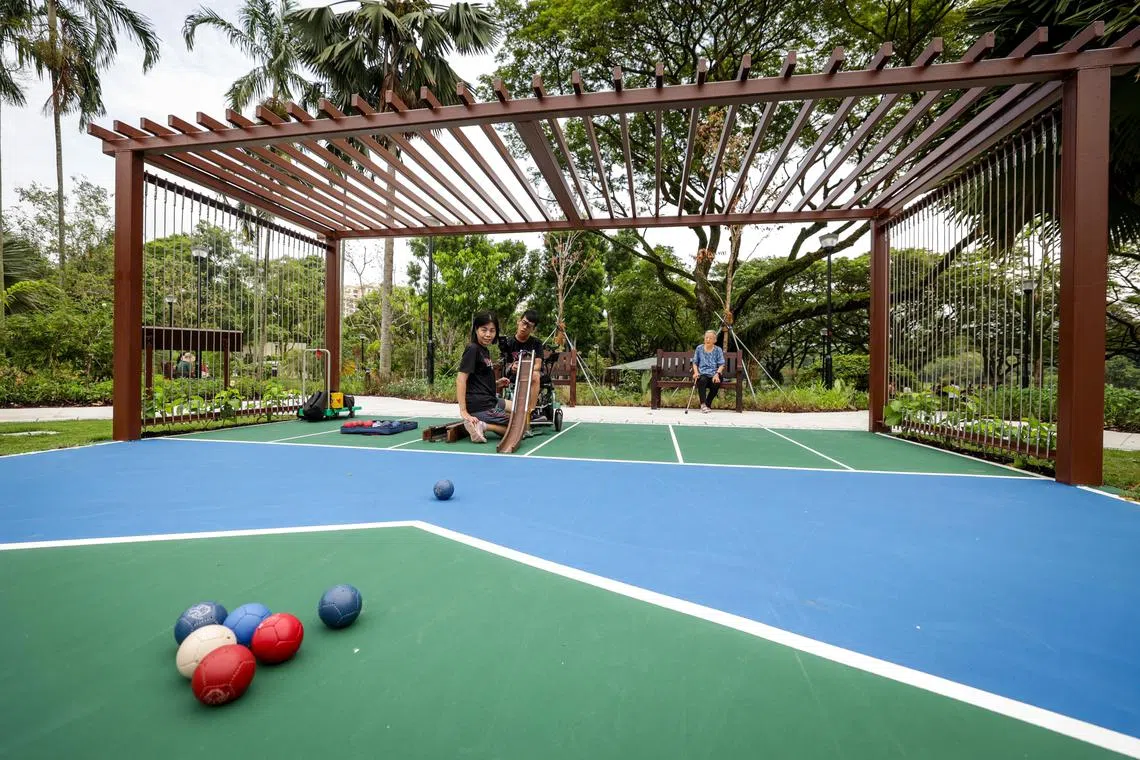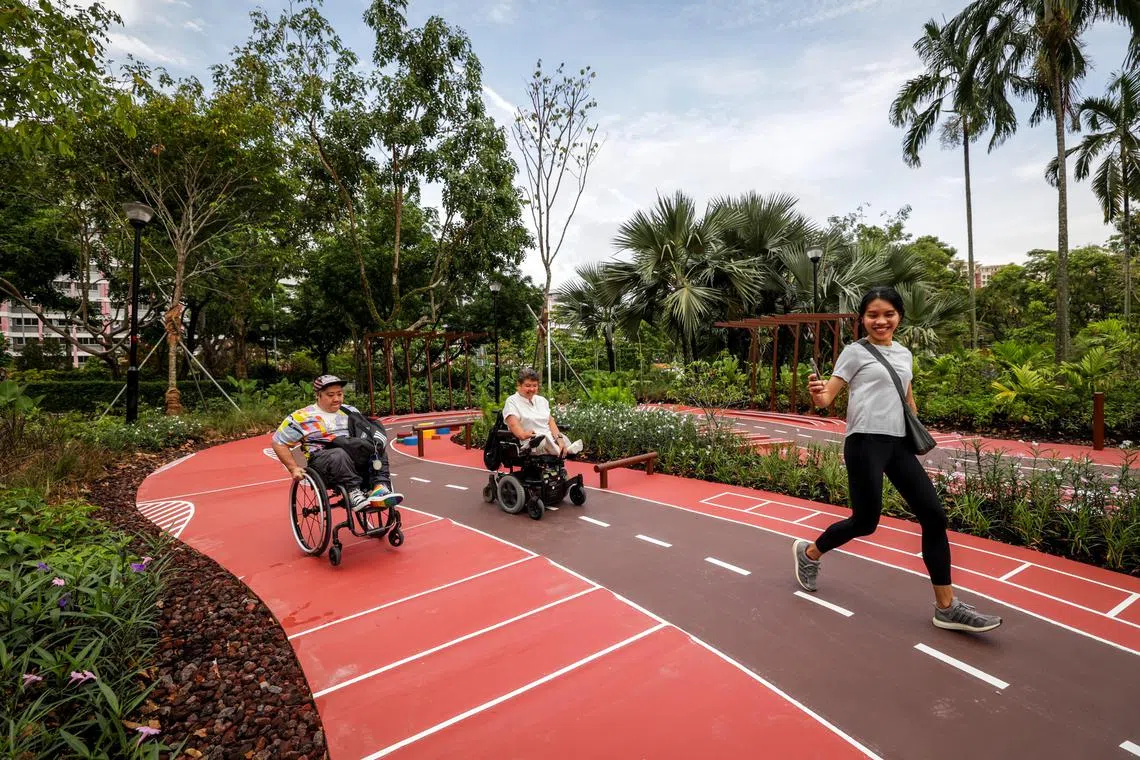Therapeutic garden opens at Punggol Park with Singapore’s first outdoor boccia court
Sign up now: Get ST's newsletters delivered to your inbox
![CMG20241212-YeapCT01/叶振忠/杨烨 /Opening of Therapeutic Garden at Punggol Park [Punggol Park]
Caption:
NParks opened the new Therapeutic Garden at Punggol Park with Singapore’s first outdoor boccia court and obstacle course specially designed for wheelchair users on 12 Dec 2024. This is the 16th therapeutic garden across Singapore and Second Minister for National Development Ms Indranee Rajah visited the park and participated in various activities with the park users.](https://cassette.sphdigital.com.sg/image/straitstimes/16cbf1b4e4bb9d80893a5b5c894fca81c46c0ad0ce564658b03615fc3cb9059e)
Therapeutic gardens help people, including those with dementia or special needs, interact with nature to improve their well-being.
PHOTO: LIANHE ZAOBAO
Follow topic:
SINGAPORE – A new therapeutic garden that features the Republic’s first outdoor boccia court opened at Punggol Park on Dec 12.
Designed to cater to a variety of visitors, including seniors and wheelchair users, the 2,000 sq m garden features the first outdoor wheelchair obstacle course within a park under the National Parks Board (NParks).
The garden also houses the first inclusive agility course located in a therapeutic garden that can be used for physiotherapy and recreation.
Therapeutic gardens help people, including those with dementia or special needs, interact with nature to improve their well-being.
Minister in the Prime Minister’s Office and Second Minister for National Development Indranee Rajah, who was at the opening of the garden on Dec 12, said therapeutic gardens are curated to foster meaningful interactions with nature, incorporating features that can enhance physical and mental well-being.
“Studies have shown that exposure to nature and gardening can reduce stress and improve mental health,” she said in a statement on Dec 12.
“We will continue to enhance our parks and gardens to provide more accessible and inclusive nature-based experiences for Singaporeans of all ages and abilities to enjoy.”
The new garden brings the number of therapeutic gardens in Singapore to 16. By 2030, there will be 30 therapeutic gardens scattered across the island. The first was developed in HortPark in 2016.
The new garden is split into two zones – an active zone where visitors can exercise, and a passive zone where people can relax.
Between the two zones stands a majestic 12m-tall rain tree planted more than 30 years ago, around which the garden was designed.

There are three meditation decks where people can unwind through activities like yoga.
PHOTO: LIANHE ZAOBAO
The garden is also filled with palm trees, including the miniature date palm, and colourful flowering plants like the scarlet milkweed, which attracts butterflies.
At the heart of the active zone is the first outdoor boccia court in Singapore. It allows users to try the Paralympic sport, and doubles as a multi-purpose court.
Boccia, which means “to bowl” in Italian, is played by wheelchair users with motor-skill impairment. The aim of the game is to bowl balls as close as possible to a white target ball called the jack.

At the heart of the active zone is the first outdoor boccia court in Singapore, which allows users to try the Paralympic sport and doubles as a multi-purpose court.
PHOTO: LIANHE ZAOBAO
Originally designed to be played by people with cerebral palsy, the sport has expanded to include athletes with disabilities affecting their motor skills.
National youth boccia player Aloysius Gan, 18, played the sport outdoors for the first time at the opening on Dec 12.
His mother, Ms Eve Cher, 44, said that playing boccia outdoors can help to increase awareness of the sport, which is usually played indoors here.

National youth boccia player Aloysius Gan, 18, played the sport outdoors for the first time at the therapeutic garden’s opening on Dec 12.
PHOTO: LIANHE ZAOBAO
Not only can her son play in an open-air environment with birds chirping in the background, but the location of the court is also more convenient for them, as it is close to their home in Punggol, she added.
Meanwhile, a wheelchair obstacle course – designed with advice from the Singapore Disability Sports Council (SDSC) – provides wheelchair users with a space to improve their mobility control and strengthen their upper body and core muscles.
Caregivers can remain close by to help wheelchair users at the course, which is flanked by a safety guiding lane.
Right beside the wheelchair obstacle course is an inclusive agility course, which is suitable for everyone, including children. It is also a space for people such as stroke patients to train their agility and movements.
It has four features, including agility ladders and agility hurdles that can help users improve leg strength and balance.

The wheelchair obstacle course – designed with advice from the Singapore Disability Sports Council – gives wheelchair users a space to improve their mobility control and strengthen their upper body and core muscles.
PHOTO: LIANHE ZAOBAO
Ms Theresa Goh, pathway and performance manager at SDSC, told The Straits Times that the garden gives wheelchair users another place to gather, and she hopes there will be more of such spaces in the future.
“The outdoor obstacle course is fun... It’s something we don’t get to use elsewhere,” said Ms Goh, who is a wheelchair user, adding that the course can also encourage outdoor play among wheelchair users.
Over at the passive zone are three meditation decks where people can unwind through activities such as yoga.
Visitors can also scan a QR code at each meditation deck and tune in to a relaxing playlist curated by NParks on music platform Spotify.
Such decks will be useful for Ms Vinita Yadav, who lives nearby, as she meditates daily.
The 50-year-old housewife, who goes to the park almost every day, said: “The garden has a calming effect on me. This will be the new addition to my walks.”



